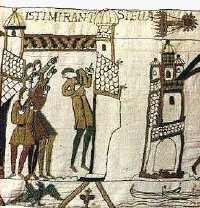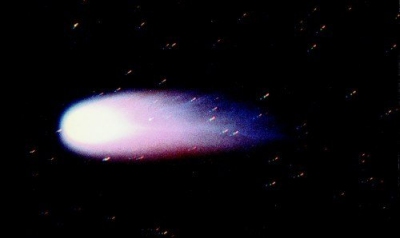Halley
About Comet Halley
 |
| Comet Halley on the Bayeux Tapestry |
Halley is important because it was the first periodic comet to be recognised. Even today, it is still the only bright comet whose orbit is well known. However, it differs from most periodic comets by taking a much longer, more leisurely route around the Sun. The comet travels in the opposite (retrograde) direction to the planets along a huge elliptical orbit which carries it beyond the orbit of Neptune. One circuit of the Sun takes 76 years to complete.
It is so bright that it has been seen and recorded for thousands of years - since at least 240 BC. For example, the 1066 apparition is shown in the famous Bayeux Tapestry which records the Norman invasion of England, while the 1301 return inspired Florentine artist Giotto di Bondone to include it in his painting of the Wise Men visiting the infant Jesus.
 |
| Halley's Comet as seen from Earth |
Comet Halley was most recently visible in 1986. The ESA spacecraft Giotto was one of an international armada of spacecraft dispatched to study the comet at that time. Giotto obtained close-up photos of Halley's nucleus, which contrary to expectation was discovered to be very dark - darker than coal, in fact, making it one of the darkest objects in the Solar System. Halley's nucleus, which is about 16 x 8 x 8 km, has a low density, indicating that it is probably porous. In summary, Halley is a large, active comet with a well-defined, regular orbit. This marks it as being rather unusual among comets. Halley will next be visible as it approaches the Sun in 2061.
 |
| Edmond Halley (RAS library, London) |
Unlike most comets, 1P/Halley is not named after the person who discovered it. Instead, it is named in honour of the 17th century English astronomer Edmond Halley (1656-1742). Using Isaac Newton's newly published theory of gravitation, Halley calculated the orbits of several comets and made the revolutionary suggestion that the bright comet seen in 1682 was the same object previously recorded in 1531 and 1607. His theory was proved to be correct when, as he predicted, the comet duly returned once more in 1758.
